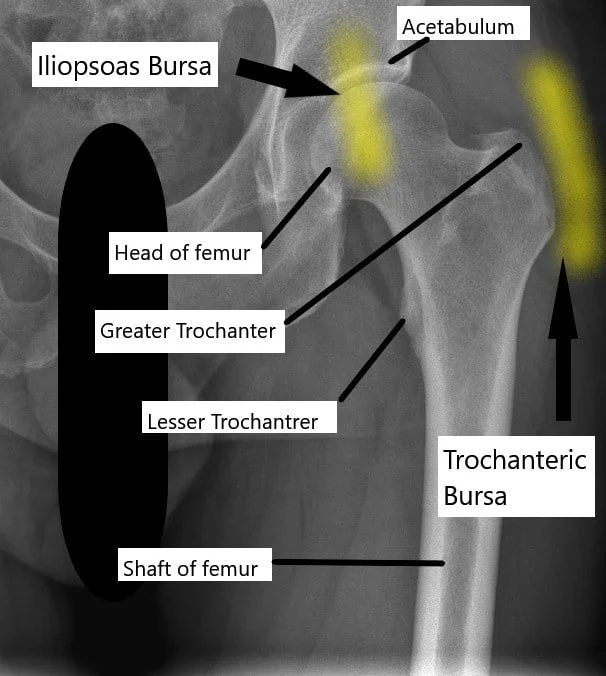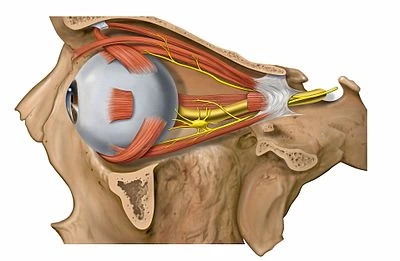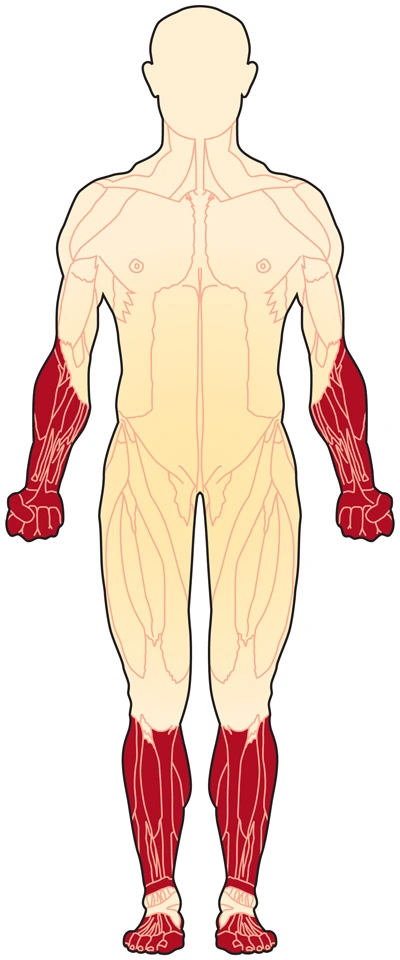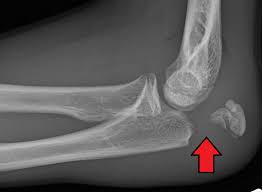Iliopsoas Bursitis
Table of Contents
Introduction
Iliopsoas bursitis is characterized by distension of the iliopsoas muscles bursa due to synovial fluid and hypertrophic synovium.
- The iliopsoas bursa is the longest synovial bursa in the body and it is present bilaterally in 98% of adults. It is located between the iliopsoas muscle or the anterior capsule of the hip, this structure is collapsed. The bursa is placed in front of the hip joints, it is adjacent to the thinnest and many vulnerable portions of the anterior capsule or reduces tendon friction over the hip during muscle action and joint movement.
- Hip disease is usually associated with it, however, isolated bursitis is present. In many cases, iliopsoas bursitis looks like a mass in the groin and inguinal region. Diagnosing iliopsoas bursitis clinically can be difficult, or imaging is usually required to differentiate iliopsoas bursitis from other inguinal masses such as lymphadenopathy, hernias, or tumors.
Clinically Relevant Anatomy
- The iliopsoas bursa is the largest bursa of the human body or is bilaterally present in 98% of adults. This bursa is bounded by the musculotendinous junction of the iliopsoas muscle (anteriorly) or by the fibrous capsule of the hip (posteriorly). It extends from the inguinal ligament superiorly to the lesser trochanter inferiorly and is flanked by the femoral vessels (medially) or the femoral nerve (literally).
- The bursa is always collapsed when in healthy condition and In some situations, the bursa is enlarged and contains fluid. When enlarged, it may cause a variety of symptoms such as pain, or immobility.
What is iliopsoas bursitis?
- Iliopsoas bursitis is an inflammation of the bursa located beneath the iliopsoas muscles. These muscles are located in front of the hip joint. A bursa is a fluid-filled sac between bones, muscles, tendons, and skin layers. It provides a cushion between tissue to decrease friction or irritation. Iliopsoas bursitis can make it difficult to walk or exercise. If you start severe symptoms, you may feel a loss of mobility.
Symptoms of iliopsoas bursitis
- Pain or tenderness that radiates from deep in the groin region or front of the hip radiating around or down the front of the thigh and down to the knee
- Increased pain with the hip flexion
- Pain in the front of the hip that will usually be experienced for a period of time during
- Vigorous activities like jogging and kicking a ball with your instep
- Getting up from the seated position
- Extending your leg while driving
- Walking up stairs
- Bringing your knee up to your chest (especially against resistance)
- Lying down without support
- Limping, which results from:
- Weakness in the upper thigh area
- Only one leg is involved
- Taking smaller steps because of hip tightness
- Hip joint stiffness and muscle tightness in the groin as well as the knee, as a result of a tight iliopsoas muscle.
Causes of iliopsoas bursitis
- There is a risk of iliopsoas bursitis if you perform repetitive motions. This injury is sometimes due to overuse of the joints, tendons, or muscles. It can develop in athletes or anyone who’s physically active, such as runners or swimmers. People with tight hip flexor muscles can also develop iliopsoas bursitis due to improved pressure. This pressure creates friction between the tendons or the bursa.
- Arthritic conditions such as rheumatoid arthritis and osteoarthritis can play a role in iliopsoas bursitis. Rheumatoid arthritis is an autoimmune disease also the immune system mistakenly attacks joints. This attack triggers joint inflammation and Osteoarthritis is a chronic arthritis condition This form of arthritis causes degeneration of joint cartilage. Degeneration causes bones to rub together and promote inflammation.
Diagnosing iliopsoas bursitis
- If you experience pain around the hip joints that radiates down your leg, see a doctor.
- Your doctor may ask about your symptoms and Be specific or explain how long you have felt the discomfort. To diagnose iliopsoas bursitis, your doctor may also complete a physical examination that includes putting stress on the bursa.
- Bursitis can mimic other medical conditions, such as tendonitis, so your doctor can diagnose the condition through a physical exam alone or Your doctor may perform imaging tests to rule out other conditions or confirm a diagnosis.
- Imaging tests capture detailed images of the inside of your body or allow doctors to identify abnormalities with the hip joint. These tests include:
- X-ray
- MRI, which uses a magnetic field or radio waves to create images hip ultrasound, which uses high-frequency sound waves to look inside the body bone scan, and nuclear medicine procedures to identify changes in bones.
Complications of iliopsoas bursitis
- fever and chills
- joint pain
- red, warm skin
- feeling sick
Differential Diagnosis
- Several joint diseases can cause distension:
- Osteoarthritis
- Rheumatoid arthritis
- Avascular necrosis
- Pigmente villonodular synovitis
- Synovial chondromatosis
- Gout
- Chondrocalcinosis
- Trauma
- Lupus erythematosus
- Pyogenic infection
- Snapping hip syndrome
- Differential diagnosis of the anterior hip pain by anatomical structure:
- Joint:
- Osteoarthritis
- Inflammatory synovitis
- Loose bodies
- Infection (septic joint)
- Crystal-induced synovitis (gout)
- Labral tears
- Bone:
- Femur:
- Stress fracture
- Avascular necrosis of the femoral head
- Bone tumor
- Infection
- Femoroacetabular impingement (two types: cam impingement occurs from an abnormal head junction of the femur and pincer impingement is because also of the over-coverage of the acetabulum)
- Femur:
- Pelvis:
- Hip fracture
- Stress fracture
- Osteitis pubis
- Muscle, tendon, bursa:
- Iliopsoas bursitis or tendinitis
- Iliopsoas strain
- Rectus femoris strain
- Tight iliotibial band
- Gluteus medius en minimus problems
- Capsular laxity causing instability (due to traumatic dislocation and overuse)
- Vasculature:
- Aneurysm
- Arteriovenous malformation
- Pelvic mass:
- Gastrointestinal causes (e.g. hernia)
- Genitourinary causes (e.g. ureteral stone)
- Nerve:
- Obturator nerve entrapment
- Myalgia paraesthetica
- Referred from the lumbar spine (L1, L2)
Treatment of Iliopsoas Bursitis
- Treatment for iliopsoas bursitis depends on the cause or the severity of the conditions. When diagnosed early, home remedies are often enough and In most severe cases, a person may need to seek medical advice to treat the pain.
- Mild cases often require little many than rest and icing to stop the inflammation. many peoples might also benefit from over-the-counter anti-inflammatory medications. People experiencing mild episodes of iliopsoas bursitis should consider stopping or reducing the activity that causes bursitis.
In many severe cases, a person seeks additional therapies. Some therapies include:
- physical therapy that focuses on hip strength and also flexibility
- corticosteroid injection is directly into the bursa
- anti-inflammatory medications
- antibiotics when the infection
- walking aids or such as canes, to relieve pressure
- If the person has arthritis, the doctor will treat the underlying condition, and Medications designed to target the arthritis symptoms will like help relieve bursitis. Persons should talk to their doctor if they experience hip pain associated with arthritis.
Stretches and exercises :
- Stretching or exercise can be used to help prevent iliopsoas bursitis. One of the primary causes is friction and rubbing which can occur when the hips are too tight. Stretching also can help alleviate the tightness.
There are many stretches that focus on the hips including the following:
Lying hip rotation
- Lie on the floor with feet flat and knees bent and Lay one ankle across the other knee. Rotate the hip in or out.

Butterfly stretch
- Sit on the floor and put the soles of the feet together. Gently push the knee toward the floor.

pigeon stretch
- The pigeon stretch help to strengthen the hips or prevent iliopsoas bursitis.
- Sit with one knee bent in front of the body at 90-degree angles, with the heel toward the opposite hip.
- Extend the other leg behind the body as far as possible and Gently move the back hip forward and backward. Repeat with the others side.
- When stretching for the first time, go very slowly or gently. Try to hold each stretch for 10-30 seconds or repeat several times on either side. Do this stretch as often as possible.
- In addition to stretching, a person may wish to strengthen their hips and Stronger hips can help prevent overuse injuries caused by inadequate support. many exercises that will help strengthen the hips are listed below.

Side kick
- Standing up, raise one leg out to the side and Do this on both sides or repeat between 10 to 15 times per side. As strength improves try adding light weights to the ankles and Holding onto a wall for balance if required.

Hip raises
- Lie on the ground with both feet planted on the floor the buttocks. Raise only one leg straight up, keeping the thighs parallel. Raise the hips off the ground and Repeat about 10 to 15 times.

Leg raises
- Place both hands or knees on the floor. Raise one foot back towards the sky or return to all-fours. Repeat on each side between 10 – 15 times.

FAQ
More people with iliopsoas bursitis feel pain in the front of the hip and the groin. it mainly radiates down the inside of the thigh to
the knee. Mainly The area can also be tender when touched. Bending (flexing) your hip—like when jogging, walking up stairs, or standing up from a seated position—makes the pain worse.
A main bursa is a fluid-filled sac between bones, muscles, tendons, and skin. It provides a cushion between tissue reduced friction and irritation. Iliopsoas bursitis can make it unique to walk or exercise. If you develop severe symptoms, you mainly may
experience reduced mobility.
Iliopsoas bursitis is simple to treat in most cases. It usually requires rest or some minimal care to increase symptoms and heals
the damage. Stretches or exercises that target the hips are helpful in preventing iliopsoas bursitis.
Pain from bursitis in your hip tends to get worse after you have been sitting and lying down. The pain may also improve when you do a repetitive activity, like climbing stairs.
Your physician and physical therapist will recommend when to start or how often to do your hip bursitis exercises. The general
recommendation is to do the stretches 2 or 3 times a day and the exercises 1 to 2 times a day as tolerated. A floor mat can be
useful and you will need a cushion and pillow.






